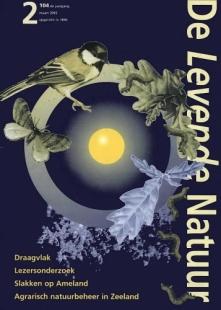De Levende Natuur nummer 2 van 2003 (English summary)
Afbeelding

High rafts result in low Black tern breeding success
Winden, J. van der
In The Netherlands rafts are provided on a large scale as artificial nest substrate for Black terns (Chlidonias niger). The risk of high-edged rafts, causing low chick survival, was noticed in several reports, but systematic studies were lacking. In 2001 in the Tienhovensche Plassen (Utrecht) high and low rafts were provided at the same site on which a colony of 24 pairs settled down: 16 on the high and 8 on the low ones. Clutch survival and colonization did not differ substantially between both types but parents were clearly more successful in raising young on low rafts (75% successful pairs) than on high rafts (53%). Especially when high rafts were situated in open water without vegetation breeding success was extremely low (22% successful pairs; 0.3 young per pair). Under these conditions small young Black terns cannot climb on high rafts, when fallen off, and starve of hunger and cold. However, when luxurious vegetation of floating water plants surrounds the rafts, the young are able to climb on the rafts again. Hence, it is recommended to use only low rafts in luxurious floating vegetation and with at least at one site an edge lower than 0.5 cm.
The effectiveness of agri-environment schemes in the province Zeeland (1989-1995)
Kleijn, D. & G.J.C. van Zuijlen
We investigated the effects of agri-environment schemes aimed to promote meadow birds by examining territory numbers on 34 fields in 1989, 1992 and 1995 in the province of Zeeland, The Netherlands. We compared numbers of territories on fields with agri-environment schemes with those on paired nearby control fields that were conventionally managed. In 1995, Black-tailed godwit (Limosa limosa), Lapwing (Vanellus vanellus) and the total number of meadow birds had significantly higher settlement densities on fields with conservation management. These differences were partly caused by the higher groundwater level of fields with meadow bird agreements. Changes in territory numbers through time were similar on fields with and without meadow bird agreements and the observed difference in settlement density in 1995 was already present in 1989. Furthermore the effectiveness of the measures did not increase with time. Thus the conservation measures themselves did not result in higher numbers of territories.
Legal and social support for nature development projects in Flanders
Bogaert, D., A. Cliquet & M. de Zitter
Within the framework of the Flemish Impulsprogramme Nature Development a research project was carried out by the Ghent University and the Arteveldehogeshool on legal and social instruments for nature development projects. The success of nature development projects does not only depend on a sound ecological basis, but also requires a good legal framework and a broad public support. The research was carried out in four nature development projects in Flanders, which were all situated on former intensively used agricultural land. A multi-actor analysis was done, using the triangulation method. In this article some of the results of this research are presented. In all four cases, there is a large public support for nature reserves amongst people living in the neighbourhood and people using the area for recreation. The so-called NIMBY-syndrome (Not In My Back-Yard) could not be confirmed in this research. However, knowledge on the nature reserve and particularly, knowledge on the accessibility of that, is an important factor in obtaining public support. There also exists a large conditional public support amongst all the categories of respondents for the transformation of agricultural land into nature areas. The most important condition that was mentioned by all groups was cooperation with local farmers. There is less public support from farmers towards nature development projects than for classical nature management measures. An important element in the arguments obtained from the farmers is the different vision on nature between farmers and environmentalists. Research was also done on the legal instruments for nature development. Legislation is often to complex. This is especially the case for the interaction between different legal instruments. A fine-tuning between all these different instruments is required. The lack of knowledge on nature policy and nature legislation amongst farmers also leads to a lack of support for nature development projects. In this article some recommendations are given to increase the public support for nature development projects.
Increased numbers of land and fresh water molluscs on Ameland
Leeuwen, S.J. van & B.F. van Tooren
The number of snail species on the Dutch Wadden island Ameland has increased strongly during the last 100 years. For fresh water molluscs the main cause is the transition of brackish to fresh water in the ditches in the polder, due to the building of dikes in the period 1915-1930. These dikes prevented the polder from inundation by sea water. In the dunes the highest numbers of species of land molluscs can be found in the forests and in the wet parts of the dunes. Planting of the forests started about 100 years ago. Many species could probably come to Ameland by the increased transport of people and materials to Ameland. The snails were probably attached to cultivated pot plants, provisions and imported garden and pond plants. However, the settlement of new species of molluscs is a slow process.

